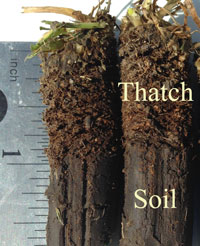Turfgrass cultivation is the process of loosening the soil to reduce compaction, reduce thatch build-up, increase water infiltration, and for alleviating many other problems that occur in turfgrass soils.
Thatch is the build-up of organic material above the soil and below the green turfgrass canopy.
Some thatch is good. Usually ½" of thatch is desirable as it acts as a filter, cushions the crowns from wear, helps moderate heat stress, and aids in weed control.
Excessive thatch can result in puffy turfgrass, disease problems, difficult weed and insect control, can become difficult to wet, and roots may begin to grow in the thatch layer instead of the soil, resulting in poor stress tolerance.

Soil compaction often occurs in turfgrass areas that receive heavy traffic, such as sports fields, playgrounds, golf courses, or a home lawn. Compaction reduces pore space in the soil. Pore space is important for drainage and air exchange needed for root growth.
Cultivation can improve water infiltration and increase pore space. This will result in better rooting and the turfgrass will become more drought and heat tolerant, withstand traffic better, and reduce insect and disease pressure.
Removes cores that are usually ¾" in diameter and about 3" deep. This should be done during active growth when the turf is not stressed. Spring and fall for cool-season turfgrasses and late spring and summer for warm-season turfgrasses.
Vibrating 4" tines shatter dry soil. There are no cores left on the surface, so this method does not help dilute the thatch layer. This is the most intensive cultivation technique and can leave the surface slightly rough for a couple days. Due to the size of the equipment, this method can only be done on large lawns or fields.